| Vocademy |
Resistors
A resistor acts like pinching a hose
What happens if you pinch a hose that has air flowing through it?- Less air will flow through the hose.
- Pressure will back up behind the pinch.
- Pressure will drop beyond the pinch.
- When air is flowing through the hose, there is a differential in pressure from one side of the pinch to the other.
- Less electrical current will flow because of the resistance.
- Voltage will back up and increase where current enters the resistor.
- Voltage will decrease where current exits the resistor.
- When current is flowing there is a differential in voltage from one side of the resistor to the other.
Here are the schematic symbols for a resistor. The top one is used in Europe and the bottom one is used in the U.S.
 |
 |
|
Schematic Symbols |
A refrigeration system has a
restriction (point 2 in the following illustration, literally a pinch
in the pipe) between the condenser and the evaporator. This causes
pressure to back up in the condenser (1), making it hot. The pressure
drops on the evaporator (3) making it cold. The restriction acts
exactly like a resistor in an electrical circuit. When the fluid flows
the pressure backs up and there is a pressure differential across the
restriction.
|
High Pressure |
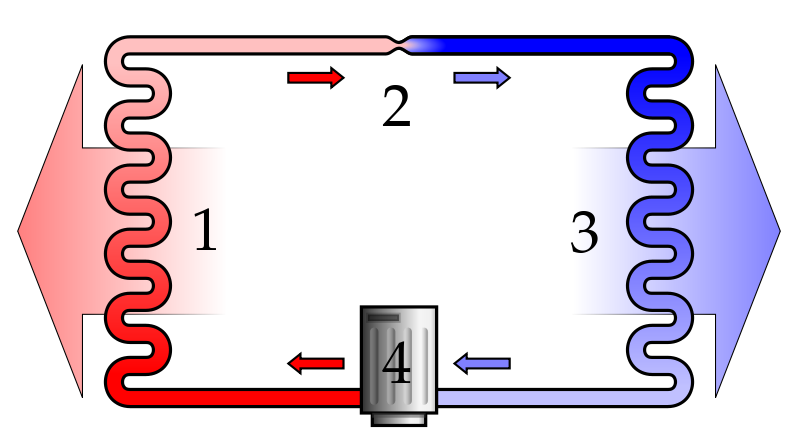 |
Low Pressure |
| The restriction (2) in a refrigeration system acts like a resistor in an electric circuit. |
Resistance, current and voltage
Whenever electrical current flows
through a resistor, the voltage will be higher at the end where the
current enters the resistor and lower at the end where the current
exits the resistor. Another way to say this is: a voltage differential
develops across a resistor whenever current is flowing through it.
Taking advantage of this property, resistors are often used to reduce voltage The greater the resistance, the greater the voltage differential across the resistor and the greater the voltage drop from the high voltage side to the low voltage side.
Garden hose analogy
Imagine you are watering your garden. As water is flowing from the garden hose, there is little pressure in the hose. If you put your hand in the stream of water, there is little force behind it. What happens if you place your thumb over the end of the hose and begin to restrict the flow of water? You will notice that as you restrict the flow, pressure builds in the hose. The more you restrict the flow, the higher the pressure in the hose. At the same time, the flow of water decreases. It will come out more forcefully, but less comes out. Placing a restriction in the hose reduces the flow of water. At the same time, a pressure difference develops on the two sides of the restriction. Another analogy is damming a river. The water level will rise behind the dam and will drop on the downstream side of the dam. The voltage, current, and resistance in an electrical circuit follow the same pattern. The rule is: When electrical current flows through a resistance, there will be a voltage across the resistance.Current plus resistance equals voltage difference
For this voltage differential to develop, there must be two things present: resistance and current. If you have current but no resistance (just a wire with no resistors or other components, i.e., a short circuit), there is no voltage differential. If you have resistance but no current, there is also no voltage differential. A resistor with no current is like a dam in a lake. There is no flow against the dam, so the water doesn't back up. The water level will remain the same on both sides. A resistor with current is like a dam on a river. Water will back up on the upstream side of the dam and drop on the downstream side. Both current and resistance must be present for a voltage differential to develop.Taking advantage of this property, resistors are often used to reduce voltage The greater the resistance, the greater the voltage differential across the resistor and the greater the voltage drop from the high voltage side to the low voltage side.
How resistors are constructed
Resistors are usually made in one of
three ways. A carbon composition resistor is made from a block of
amorphous carbon. They are the least expensive and least precise of the
three. A wire-wound resistor is made from a coil of high resistance
wire wound on an insulator. They are more precise than carbon
composition but much more expensive. A good compromise between
precision and price are thin and thick film resistors. They are made
from a coating of resistive material vacuum-deposited on a ceramic
substrate. Resistors may be packaged individually with wires
attached or as surface-mount chips. They may even be printed on circuit
boards with resistive ink. Resistors also come as several in a single
package called a resistor array.
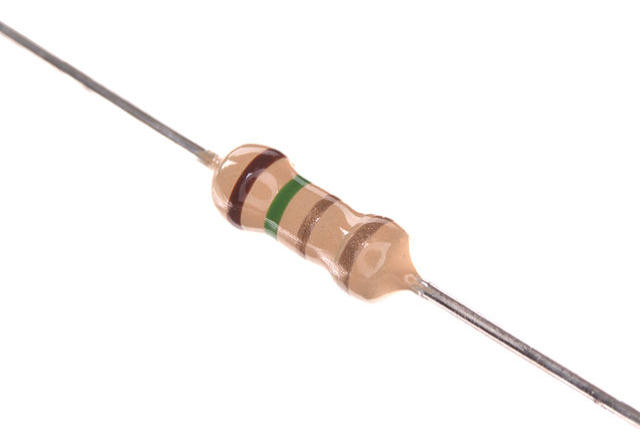 Discrete Resistor |
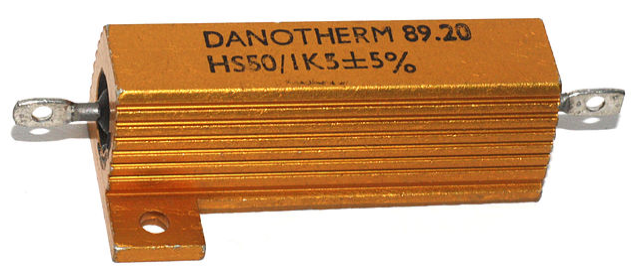 Power Resistor |
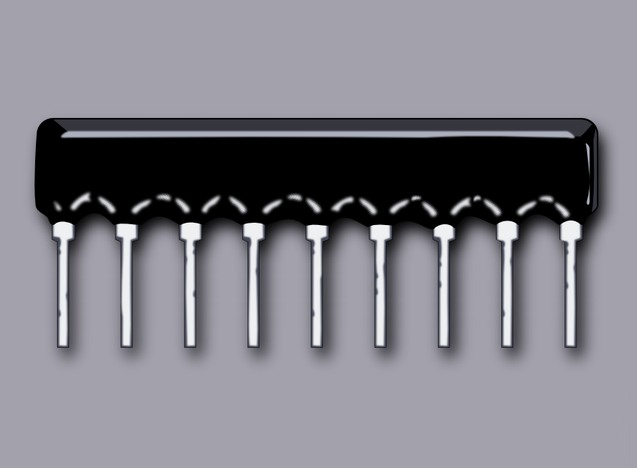 Resistor Array |
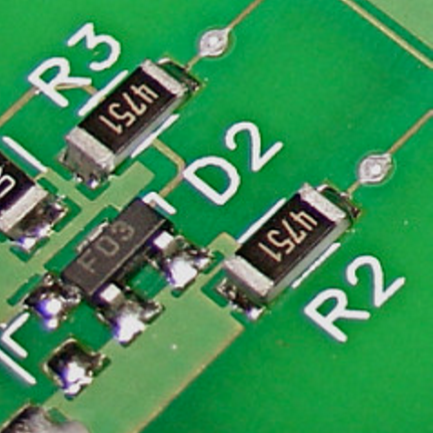 Surface Mount Resistors |
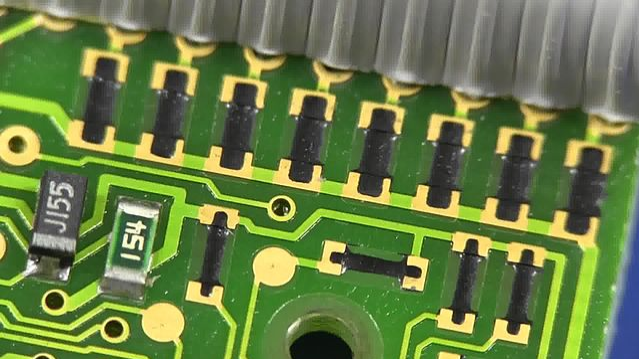 Carbon Printed Resistors |
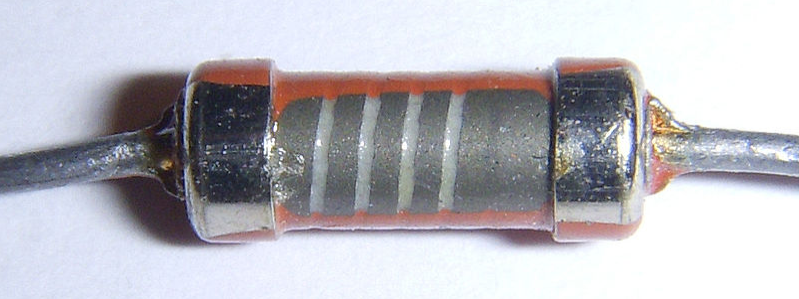 Carbon Film Resistor (a manufacturing defect exposes the construction). |
Thermistors
Resistors that measure temperature
When we discussed wire, we noted that a hot wire can carry less current than a cold wire. This means that as its temperature increases the wires resistance increases. Resistors act the same way. If you heat up a resistor, its resistance will increase. A thermistor is a resistor that has a radical change in resistance when the temperature changes.
 |
|
 |
|
A typical Thermistor |
|
Schematic Symbol |
Thermistors are used to measure temperature. A common place to find thermistors is within a CPU socket on a computer motherboard. This is used to measure the CPU temperature.
Positive and negative temperature coefficients
Most materials will have an increase in resistance as temperature increases. However, other materials have a decrease in resistance as temperature increases. This is called a negative temperature coefficient (NTC). Thermistors come in both positive and negative temperature coefficient types.Page summary:
The rules for resistors are:
- A resistor will reduce the flow of current.
- A higher value resistor will reduce current flow more than a lower value resistor.
- When current flows through a resistor, the voltage is higher where the current enters the resistor than where the current exits.
- This voltage differential is often called a voltage drop.
- Assuming equal current, a higher-value resistor will have a greater voltage drop than a lower-value resistor.
- A thermistor with a negative temperature coefficient will have a lower resistance at higher temperatures.
Resistors
| Vocademy |